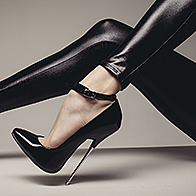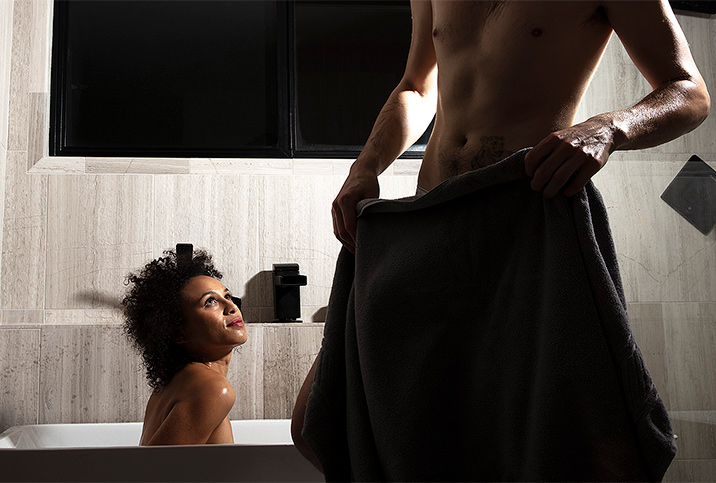Dripping With Delight: The Truth About Using Candle Wax for Sex

So, you're interested in introducing wax into the bedroom. I'll spare you the puns about "heating things up" and "getting hot and heavy." While it's commonly considered BDSM, hot wax play is a form of sensation play that can fall under the BDSM umbrella, but it doesn't necessarily have to.
Sensation play, specifically temperature play, is about exposing the body to different or unexpected temperatures. This can include anything from bringing superhot wax into the bedroom to freezing a sex toy before use. Wax play can be as intense as you want it to be, from massage candles that melt at body temperature to paraffin, high-melting-point candles made specifically for sadomasochistic wax play.
Don't rush to the pantry and fish out those old birthday candles from the back, though. Hot wax play requires a little more care, attention and technique than just lighting the wick.
What's wax play, exactly?
Wax play is a "gateway kink," according to Dirty Lola, a sex educator and creator of Sex Ed A Go-Go, a go-go dancing show and sex ed Q&A. Shag, a sex shop in the Williamsburg neighborhood of Brooklyn, New York, where Lola also works, caters to beginner kink.
"We get a lot of people who want to spice things up or are looking to explore something new, and wax play feels less subversive, so it's easier to access," she said.
"You don't need to enjoy pain or intense sensation for wax play," said Gloria Brame, an Athens, Georgia-based sexologist and author. "Done safely, it can simply be a sensual exploration of your body's reactions to temperature change."
This is why the hot wax kink is more often a part of sensation play than part of BDSM, because the body reacts to different kinds of stimuli on the skin, only one of which is pain. The heat of the wax is only one aspect of wax play. The anticipation of wax dripping onto your skin, the sensation of it cooling and hardening on skin, the removal of the wax—each sensation plays an equal part in the experience. Experimenting with the practice is key to discovering what you like best.
What's the best temperature for hot wax for sex?
According to both Lola and Brame, one of the keys to wax play is the melting point.
"The longer it takes to melt something, the hotter it will be," Lola said.
Low-temperature candles melt quicker, so the wax is more beginner-friendly and less likely to feel too intense or cause burns. The other way to adjust the temperature of the wax during play is by changing the distance from which you drip the candle, which gives the wax more time to cool in the air as it falls. While candles can vary in melting point, changing the height is a great way to adjust to your partner's desires at the moment and find the temperature they enjoy the most.
Low-temperature candles are widely available and often labeled according to the melting point. You can use massage candles or specialized wax-play candles—wherever you buy them, make sure to read the instructions carefully and test the candle on yourself before using it on anyone else.
While massage wax-play candles are often made of especially low-melting-point ingredients and oilier substances such as soy, many common wax-play candles are made of paraffin. It seems like paraffin is the best way to go for the drip-and-harden effect, whereas oilier candles have a lower burn rate and less smoke than other candles. Paraffin candles can differ from one another in the grade of the paraffin used, but this isn't all that important. Whether you're a beginner or a seasoned pro, you should primarily focus on melting points when choosing a candle.
If you need to use a nonspecialized candle for whatever reason, keep it simple and safe with a pure white, unscented, undyed candle.
Both Brame and Lola emphasized the danger of using any regular household candles you might have lying around.
"Household candles typically have a much higher melting point," Lola warned, adding that "candles with scent can give you a third-degree burn because the scents themselves can get superheated."
Brame also cautioned against using any candles with dyes or fragrances, as the different melting points and heat of other added ingredients in a candle can cause chemical burns. While it might be tempting in the moment to grab whatever is on the bedside table, it's important to remember you're playing with fire. Literally. If you need to use a nonspecialized candle for whatever reason, keep it simple and safe with a pure white, unscented, undyed candle.
"Experiment by holding the lit candle high [up to 16 to 24 inches], then tilting your wrist to slowly drizzle a few drops of wax to see how your partner reacts," Brame advised beginners. "If they like it, slowly bring the candle a few inches closer and keep repeating until you get the desired response. Don't get too close—maintain an eight- to 10-inch distance from bare skin."
It's always better to err on the side of caution than risk someone becoming injured. Moving at a slow pace can also help you and your partner listen and react to each other to find your exact preferred technique and intensity.
Setup and aftercare after hot wax play
A little setup goes a long way with wax play. You want to keep wax away from anything it might stain, like bedsheets, furniture, rugs and so on. Massage candles can leave hard-to-remove oil stains on fabrics, and any dyes in candles can seep into fabrics and unstained wood.
Lola recommended using an old sheet or a small tarp to avoid making too much of a mess on anything you don't want to risk getting wax on. Of course, you don't need to use a barrier to prevent a mess, but placing some kind of disposable sheet underneath your partner is helpful for anyone worried about dripping wax.
More important than furniture safety, however, is the safety of you and your partner during play. Make sure to test your candle on yourself before using it on another person, until you feel confident that you know what you're doing when you introduce a partner into the mix. Pay attention to one another's boundaries, and check in as you go.
"A low-temperature wax, fragrance/dye-free candle held at the recommended distance should not cause burns or irritations," Brame said. "But if you accidentally burn or get burned, stop what you're doing. Keep ice or a cold, wet towel handy to apply to the burn immediately and add a topical antibacterial like Neosporin."
Having a cool rag and water nearby is a great precaution for anyone playing with wax, not just beginners. These items can soothe any sensitive areas of skin or ease the pain of burns should they occur.
"Aftercare usually means carefully removing the dried wax," Brame said. "That shouldn't hurt unless you dripped it onto hair. Ouch. Otherwise, it should be easy to crack the wax off skin when it cools."
Peeling off the hardened wax is often part of the sensation play itself; you can use any thin, hard-edged object, including knives, credit cards, gift cards and plastic combs, to scrape off wax—whatever works without irritating or injuring the skin of your partner. If you opt to use a knife, make sure you are careful and experienced enough to peel the wax off without risking injury.
Aftercare can differ based on your initial technique of dripping wax. The amount or type of aftercare for wax play will differ from person to person. You can make aftercare more pleasant and relaxing by making sure to drip only in certain designated areas.
"Don't drip it onto hair, scalp, the face, and avoid [or be extra careful around] sensitive areas like nipples and genitals, which will react more intensely than body skin. Avoid any skin that is irritated, prone to rashes or has open sores/bruises," Brame advised.
Is hot wax play safe?
The short answer is yes, wax play is safe. Just stay smart and mindful of what you're doing. You might want to remove that draped canopy over your bed before lighting up a candle, and keep anything too flammable away from the area. Keep a lamp or overhead bulb on in the area so the candle isn't your only source of light. You don't want to trip or find yourself without a light if something goes wrong.
There are also physical aspects to consider before you engage in wax play. Anyone with a skin condition, such as psoriasis, eczema or even a light sunburn, should ask their doctor before proceeding and maybe find a different way to engage in the practice that doesn't involve fragile, easily damaged parts of the skin. The same goes for anyone on medications that affect the skin, including Accutane, some cardiac medications, antibiotics, diuretics and many other kinds of prescription or over-the-counter drugs. Your doctor can tell you whether your medications might cause your skin to react badly to temperature play, or if you have a condition that might prohibit you from engaging in wax play.
And, of course, practice makes perfect. While reading up on wax play before you light the match is smart, it doesn't hold a candle to the real thing.




















